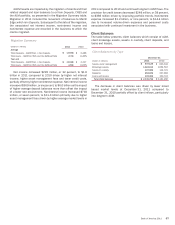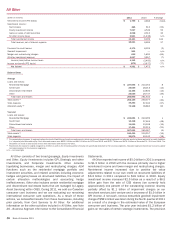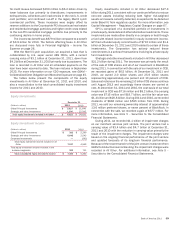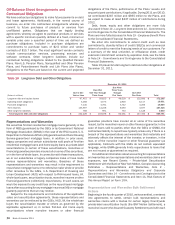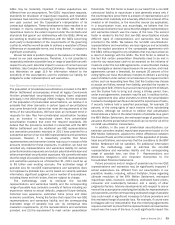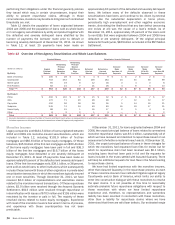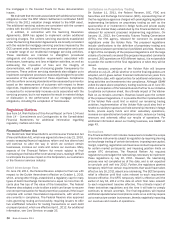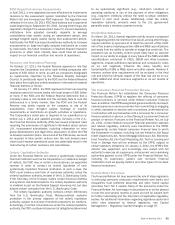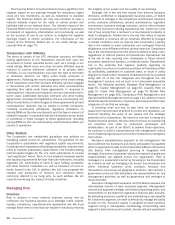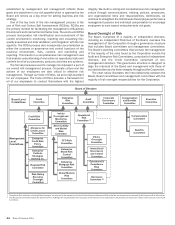Bank of America 2011 Annual Report Download - page 59
Download and view the complete annual report
Please find page 59 of the 2011 Bank of America annual report below. You can navigate through the pages in the report by either clicking on the pages listed below, or by using the keyword search tool below to find specific information within the annual report.Bank of America 2011 57
of possible loss related to non-GSE representations and warranties
exposure as of December 31, 2011 included possible losses
related to these monoline insurers.
Whole Loans and Private-label Securitizations
Legacy entities, and to a lesser extent Bank of America, sold loans
to investors as whole loans or via private-label securitizations. The
majority of the loans sold were included in private-label
securitizations, including third-party sponsored transactions. The
loans sold with total principal balance of $778.2 billion, included
in Table 12, were originated between 2004 and 2008, of which
$409.4 billion have been paid in full and $186.1 billion are
defaulted or severely delinquent at December 31, 2011. In
connection with these transactions, we provided representations
and warranties, and the whole-loan investors may retain those
rights even when the whole loans were aggregated with other
collateral into private-label securitizations sponsored by the whole-
loan investors. At least 25 payments have been made on
approximately 64 percent of the defaulted and severely delinquent
loans. We have received approximately $10.9 billion of
representations and warranties claims from whole-loan investors
and private-label securitization investors related to these vintages,
including $6.1 billion from whole-loan investors, $2.2 billion from
private-label securitization trustees, $1.7 billion in claims from
private-label securitization investors in the Covered Trusts received
in 2010, and $819 million from one private-label securitization
counterparty which were submitted prior to 2008. In private-label
securitizations, certain representation thresholds need to be met
in order for any repurchase claim to be asserted by the investors.
The majority of the claims that we have received outside of those
from the GSEs and monolines are from third-party whole-loan
investors. However, the amount of claims received from private-
label securitization trustees that meet the required standards has
been increasing. In 2011, we received $2.1 billion of repurchase
claims from private-label securitization trustees. In addition, there
has been an increase in requests for loan files from private-label
securitization trustees, as well as requests for tolling agreements
to toll the applicable statutes of limitation relating to
representations and warranties claims, and we believe it is likely
that these requests will lead to an increase in repurchase claims
from private-label securitization trustees that meet the required
standards.
We have resolved $6.1 billion of the claims received from whole-
loan investors and private-label securitization investors with losses
of $1.4 billion. Approximately $2.8 billion of these claims were
resolved through repurchase or indemnification and $3.3 billion
were rescinded by the investor. Claims outstanding related to these
vintages totaled $4.8 billion, including $2.8 billion that have been
reviewed where it is believed a valid defect has not been identified
which would constitute an actionable breach of representations
and warranties and $2.0 billion that are in the process of review.
Certain whole-loan investors have engaged with us in a
consistent repurchase process and we have used that experience
to record a liability related to existing and future claims from such
counterparties. The BNY Mellon Settlement led to the
determination in the second quarter of 2011 that we had sufficient
experience to record a liability related to our exposure on certain
other private-label securitizations. However, the BNY Mellon
Settlement did not provide sufficient experience related to certain
private-label securitizations sponsored by third-party whole-loan
investors. As it relates to certain private-label securitizations
sponsored by third-party whole-loan investors and certain other
whole loan sales, it is not possible to determine whether a loss
has occurred or is probable and, therefore, no representations and
warranties liability has been recorded in connection with these
transactions. Our estimated range of possible loss related to non-
GSE representations and warranties exposure as of December 31,
2011 included possible losses related to these whole loan sales
and private-label securitizations sponsored by third-party whole-
loan investors.
Private-label securitization investors generally do not have the
contractual right to demand repurchase of loans directly or the
right to access loan files. The inclusion of the $1.7 billion in
outstanding claims noted on page 57 does not mean that we
believe these claims have satisfied the contractual thresholds
required for these investors to direct the securitization trustee to
take action or that these claims are otherwise procedurally or
substantively valid. One of these claimants has filed litigation
against us relating to certain of these claims; the claims in this
litigation would be extinguished if there is final court approval of
the BNY Mellon Settlement. Additionally, certain private-label
securitizations are insured by the monoline insurers, which are not
reflected in these amounts regarding whole loan sales and private-
label securitizations.
Other Mortgage-related Matters
Servicing Matters and Foreclosure Processes
We service a large portion of the loans we or our subsidiaries have
securitized and also service loans on behalf of third-party
securitization vehicles and other investors. Servicing agreements
with the GSEs generally provide the GSEs with broader rights
relative to the servicer than are found in servicing agreements with
private investors. For example, each GSE typically claims the right
to demand that the servicer repurchase loans that breach the
seller’s representations and warranties made in connection with
the initial sale of the loans even if the servicer was not the seller.
The GSEs also claim that they have the contractual right to demand
indemnification or loan repurchase for certain servicing breaches.
In addition, the GSEs’ first mortgage seller/servicer guides provide
for timelines to resolve delinquent loans through workout efforts
or liquidation, if necessary, and purport to require the imposition
of compensatory fees if those deadlines are not satisfied except
for reasons beyond the control of the servicer, although we believe
that the governing contracts, our course of dealing, and collective
past practices and understandings should inform resolution of
these matters. In addition, many non-agency RMBS and whole-
loan servicing agreements require the servicer to indemnify the
trustee or other investor for or against failures by the servicer to
perform its servicing obligations or acts or omissions that involve
willful malfeasance, bad faith or gross negligence in the
performance of, or reckless disregard of, the servicer’s duties. It
is not possible to reasonably estimate our liability with respect to
potential servicing-related claims. While we have recorded certain
accruals for servicing-related claims, the amount of potential
liability in excess of existing accruals could be material.
In October 2010, we voluntarily stopped taking residential
mortgage foreclosure proceedings to judgment in states where
foreclosure requires a court order following a legal proceeding
(judicial states) and stopped foreclosure sales in all states in order
to complete an assessment of related business processes. We
have resumed foreclosure sales in nearly all non-judicial states.
While we have resumed foreclosure proceedings in nearly all
judicial states, our progress on foreclosure sales in judicial states


